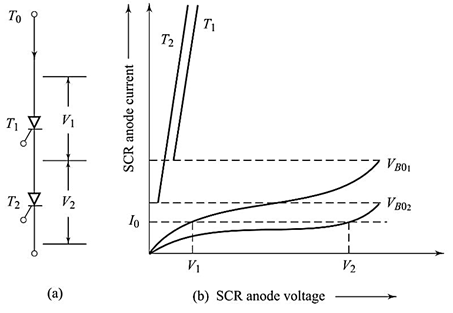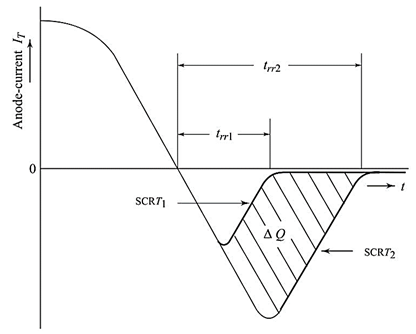Series Operations of Thyristors
Series Operations of Thyristors
If the required voltage rating of the assembly or equipment incorporating thyristors is more than the voltage rating of a single thyristor, then several thyristors have to be united in a series connection. When we consider a series connection of thyristors, we mean thyristors of the same class to be connected in series. Like any other semiconductor device, characteristic properties of two thyristors of same make and rating are never same and this leads to the following two major problems during series connection of the devices.
(1) Unequal distribution of voltage across devices; and
(2) Difference in reverse-recovery characteristics.
(1) Unequal Distribution of Voltage
The problem of unequal voltage sharing between series connected SCRs can be understood by referring to Figure 26. Figure 26 shows the V-I characteristics of two identical SCRs. Here, VBO1 and VBO2 are the forward breakover voltages for thyristors T1 and T2, respectively. For SCR T2, leakage-resistance (V2/I0) is high whereas for SCR T1 it is low (V1/I0).
For the same leakage-current I0 SCR T2 supports rated voltage V2 which is nearly on the point of breakdown, whereas SCR T1 supports voltage V1 which is less compared to V2. Hence, thyristor having the highest leakage resistance (or low leakage current) will share a larger portion of the applied voltage.

Figure 26
This shows that when the thyristors of identical rating are connected in series, variations in their forward and reverse blocking characteristics causes unequal distribution of voltage in steady-state.
It is observed from Figure 26 that the maximum voltage that the two-SCR string can block is only (V1 + V2) and not the rated blocking voltage 2V2. Hence, in order to force equal sharing of voltages across the two SCRs under steady state condition, external resistors R have to be connected in parallel with each thyristor such that the parallel combination has the same resistance. The voltage sharing in series connected SCRs could also be achieved by connecting controlled avalanche rectifiers or metal oxide varistors across each thyristor in series string.
(2) Difference in Reverse Recovery Characteristics
The unequal distribution of voltages among thyristors in series also occurs during the transient conditions of turn-off, turn-on and high-frequency operation. A thyristor which has the largest turn-on time in the series string will have to momentarily support the full-string voltage. One method that can be used to minimise the unbalance caused by dissimilar turn-on delays is to apply high enough gate-drive with fast rise-time to minimise turn-on differences. If one thyristor in the string has short reverse-recovery time, it will alone support the string reversevoltage. The problem of unequal voltage sharing among the series connected SCRs, due to difference in reverse recovery characteristics of the two unmatched SCRs, of the same type, can be understood by referring to Figure 27.

Figure 27
As shown in Figure 27, SCR T1 is assumed to have less reverse-recovery time than that of SCRT2. As a result, SCRT1 recovers faster than SCR T2 and it limits the reverse-current immediately. Therefore, SCRT1 will share the maximum string voltage as SCRT2 is not recovered. Hence, unequal voltage distribution occurs due to the difference in the reverse-recovery currents of the SCRs of the same time. Here, shaded area DQ represents the difference in reverse recovery charges of two thyristors. During turn-off, the capacitance of the reverse-biased junction determines the voltage distribution across SCRs in a series-connected string. As reverse-biased junctions are likely to have different capacitances, called self capacitances, the voltage distribution during turn-on and turn-off periods would be unequal.
latest video
news via inbox
Nulla turp dis cursus. Integer liberos euismod pretium faucibua








